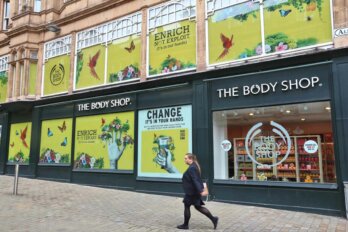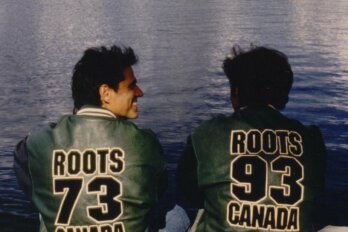Displaced by fire, a white goose takes flight in search of a new home. Chased off by vultures, it can’t settle anywhere. It crosses oceans, deserts, storms. Then, suddenly, below: snow, holiday lights, a house beside a lake. The lonely bird peers through a window at a family decorating a Christmas tree. It looks up to find a Canada goose welcoming the migrant into its flock—a flock of various feathered types, presumably all forced from their original homes too.
This sixty-second spot aired in 2022 and was intended to induce a craving for, of all things, dark roasted brew. Marketing long ago gave up the hard sell in favour of coaxing us into fuzzy feelings: love, pride, nostalgia. Tim Hortons has maybe done more than any other Canadian franchise to test the fuzzier limits of that strategy. For sixty years—the company marks its anniversary this month—the coffee and donut chain has tried to connect consumers with the idea of Canada as the cold country with a heart, or, more specifically, with “the shared values and traditions of Canadians being kind to each other and making everyone feel welcomed,” according to Hope Bagozzi, the company’s chief marketing officer.
The goose commercial, called “KindNest,” aligns with the brand’s earlier effort: the True Stories campaign, which loosely re-enacted anecdotes posted on the company’s website. In one emotional ad, an immigrant reunites with his wife and kids at an airport, carrying bags of winter garb for them. Another is centred around first- and second-generation Canadians. It’s set in a hockey rink where a son learns that his strict father, sitting beside him, would sneak in to watch his games—its trauma thwarted but with a happy ending: peace via a unique blend of 100% Premium Arabica beans, a healing balm found only at Timmies. It’s advertising, so any settler anxiety or real-life racism is side-stepped in favour of the fantasy: we’re good people, aren’t we? Posing the question may well be part of the Canadian identity. But Tim Hortons proposes that we approach the answer not through reflection or debate but through commerce: the purchase of a double-double (or, for a limited time this year, a Dutchie, one of four donuts the chain is reviving). Canadians, it’s said, are consumer citizens. Politicians get it.
That insight was especially hard to miss in the lead-up to the 2011 federal election. According to Douglas Hunter, author of Double Double: How Tim Hortons Became a Canadian Way of Life, One Cup at a Time, political wisdom had created a mythical creature known as a “Tim Hortons voter”: working class, not too liberal, not too conservative, average. This voter was distinct from the Starbucks voter: elite, Laurentian, learning the coded, bookish language of Tall, Grande, Venti, framed as both part of the fun and a necessary barrier to getting something hot to drink (“Please, just give me a large coffee!”). In that election, Michael Ignatieff, a Liberal leader fighting for his political life, tried to shed a highbrow reputation by taking every opportunity to be photographed with a Tim Hortons cup. That is until reporter Susan Delacourt spotted a Starbucks cup on the Liberal campaign bus and snapped a picture, sealing his fate. By then, Canadian media had coined the nickname Starbucks Liberals. Stephen Harper, more clearly a Tims man, won a majority.
The political juice Tim Hortons holds remains potent. It’s why former Conservative justice minister Peter MacKay once met a reporter at an Ottawa location in 2013 (a detail that appeared in a profile of MacKay that also included an anecdote of how candidates in Nova Scotia needed to show up at Tim Hortons by 7:30 a.m. “Well, at that Tims, it’s Tories until 8, then Liberals after. If we show up at 8:30, there’ll be fighting.”) It’s why Conservatives ginned up a controversy on social media in 2020 around Trudeau buying gourmet donuts for staff rather than, say, picking up some Timbits, $4.99 for twenty assorted. It’s also why Pierre Poilievre chose to bring Tims to Ottawa’s protesting convoy-ites in 2022.
“The fascinating thing,” Hunter says now, referring to how politicians and media forged the link between Tim Hortons and unpretentious patriotism, “is that the company didn’t have to do anything.” It’s worth noting the company—founded in 1964 by hockey player Tim Horton, who died in 1974 at age forty-four (car crash, highway)—was bought by franchisee Ron Joyce, the year after Horton died, for a million dollars and a Cadillac Eldorado. Today, it is controlled by one of the world’s largest restaurant companies, Restaurant Brands International, which also owns Burger King and Popeyes. Hunter adds, “Tims is always going to be able to lean on the ordinary Canadians thing in their advertising. It is a habit.” Some habits are not only hard to break but provide good shareholder value: after a COVID-19 slump, RBI’s net income for 2023 hit $726 million (US), more than double since the year before.
A chunk of that dough likely came from caffeinated consumer citizens investing in the idea of Canadian identity. But it goes beyond product: as Patricia Cormack and James F. Cosgrave write in Desiring Canada: CBC Contests, Hockey Violence and Other Stately Pleasures: “Tim Hortons offers back what private industry, and the ideology of the free enterprise, have removed from the public sphere.” Cormack and Cosgrave conjure a folkloric history of Canadian safety and comfort, the place to go when times are tough, the weather is cruel, and life promises death and poor crops. They cite Baking as Biography, a 2010 ethnography in which women’s baking is recalled as a service to the community, mostly in churches, where the pot of coffee is likewise on a wood stove and hot. The argument goes: these rituals and their real estate have been taken over by Tims, now a stand-in for the public space, the space in which to perform democracy safely. Where privatization removes parks, clubs, and community centres and turns them into condos and locked doors, Tims offers a place to hang out.
Sanctuary from hostility at Tims now involves hockey card trading nights, advertised as a family-cementing pastime, but in the part of the country where I live, it looks much more like an attempt to anxiously stir up nostalgia in men in Winnipeg Jets jerseys (original logo) who stopped drinking in bars. And globalization means the coffee is being crowded out: new items include Sweet Chili Chicken Loaded Wraps and Loaded Bowls, Tiramisu Cold Brew, and Blackberry Yuzu Sparkling Quenchers—just like the Antigonish church ladies used to make.
Let’s get back to that wandering goose. The Canada goose leads him to a winter pond free of predators and adversaries. But it’s a parable (all proceeds from the associated children’s book went to the United Nations Refugee Agency) for the very Canadian kinship that the brand isn’t quite fostering anymore. Tim Hortons has tested walk-up windows (order from the sidewalk, take your coffee, never have to go inside), automated drive-thrus that eliminate contact with staff (an idea inspired by the COVID-19 pandemic), and drive-thru-only stores with nowhere to sit inside. None of which acts as a metaphor for collective citizenship.
It’s possible Tim Hortons doesn’t so much represent Canadian identity but confuses it (Sweet Chili Chicken, Tiramisu, Sparkling Quenchers). Or maybe that cultural confusion is just what we mean by Canadian identity in the first place. As Cormack and Cosgrave write, “While Tim Hortons marketing and advertising is nostalgic, its nostalgia takes advantage of the gaps, contradictions, and dissatisfactions left by official Canadian versions of the past and the present.” In other words, the country is a puzzle, and Tim Hortons understands this. Is there an official, graspable Canadian identity? No. We are fraught with incomplete reconciliation, spats about carbon and immigration, and regional jealousy. Tims bears witness to it and makes bearing it easier. It’s where a tired refugee can land. It’s hockey cards and retro treats. Identity crisis? Here’s some quick-serve in a large red cup, brewed fresh every twenty minutes.






